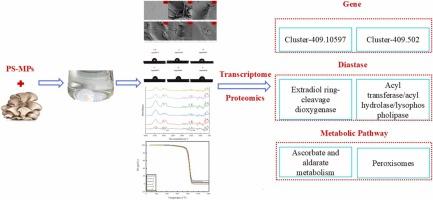五种食用菌对聚苯乙烯微塑料的降解效率及机理研究
IF 11.3
1区 环境科学与生态学
Q1 ENGINEERING, ENVIRONMENTAL
引用次数: 0
摘要
微塑料对环境和人体的危害已成为人们关注的热点问题,筛选潜在降解微塑料的微生物迫在眉睫。本研究首次利用木耳、平菇、灵芝、肺侧耳和鸡胸侧耳降解PS-MPs。降解50 d后,平均降解率约为7.494%,其中平菇的最高降解率为16.17±8.87%。此外,通过扫描电镜和傅里叶变换红外光谱等表征方法,证实了5种食用菌对PS-MPs的降解能力。最后,通过转录组和蛋白质组分析,首次将参与平菇PS-MPs降解的基因Cluster-409.10597、Cluster-409.502和Cluster-409.6781鉴定为Extradiol环裂解双加氧酶、酰基转移酶/酰基水解酶/溶血磷脂酶等酶。此外,还确定了在醛酸盐代谢中起作用的抗坏血酸和过氧化物酶体代谢途径。本研究首次对平菇的降解机制进行多组联合分析,为更全面地了解食用菌对PS-MPs的降解奠定理论基础,拓宽食用菌资源作为工程真菌的应用方向。本文章由计算机程序翻译,如有差异,请以英文原文为准。

Study on the degradation efficiency and mechanism of polystyrene microplastics by five kinds of edible fungi
The harm caused by microplastics to the environment and human body has become a hot issue, and screening for microorganisms that potentially degrade microplastics is urgently needed. This study is the first to use Auricularia auricula, Pleurotus ostreatus, Ganoderma lucidum, Pleurotus pulmonarius and Pleurotus cornucopiae to degrade PS-MPs. After 50 d of degradation, the average degradation rate was approximately 7.494 %, with the highest degradation rate of Pleurotus ostreatus being 16.17 ± 8.87 %. In addition, the ability of five edible fungi to degrade PS-MPs was confirmed through characterization methods such as scanning electron microscopy and Fourier transform infrared spectroscopy. Finally, for the first time, through the transcriptome and proteome, the genes Cluster-409.10597, Cluster-409.502, and Cluster-409.6781, along with other genes involved in the degradation of PS-MPs in Pleurotus ostreatus, were identified as Extradiol ring-cleavage dioxygenases, Acyl transferase/acyl hydrolase/lysophospholipase, and other enzymes. Additionally, the Ascorbate and Peroxisomes metabolic pathways, which play a role in aldarate metabolism, were also identified. This study is the first multiomic joint analysis of the degradation mechanism of Pleurotus ostreatus, laying a theoretical foundation for a more comprehensive understanding of the degradation of PS-MPs by edible fungi and broadening the directions for the application of edible fungal resources as engineered fungi.
求助全文
通过发布文献求助,成功后即可免费获取论文全文。
去求助
来源期刊

Journal of Hazardous Materials
工程技术-工程:环境
CiteScore
25.40
自引率
5.90%
发文量
3059
审稿时长
58 days
期刊介绍:
The Journal of Hazardous Materials serves as a global platform for promoting cutting-edge research in the field of Environmental Science and Engineering. Our publication features a wide range of articles, including full-length research papers, review articles, and perspectives, with the aim of enhancing our understanding of the dangers and risks associated with various materials concerning public health and the environment. It is important to note that the term "environmental contaminants" refers specifically to substances that pose hazardous effects through contamination, while excluding those that do not have such impacts on the environment or human health. Moreover, we emphasize the distinction between wastes and hazardous materials in order to provide further clarity on the scope of the journal. We have a keen interest in exploring specific compounds and microbial agents that have adverse effects on the environment.
 求助内容:
求助内容: 应助结果提醒方式:
应助结果提醒方式:


